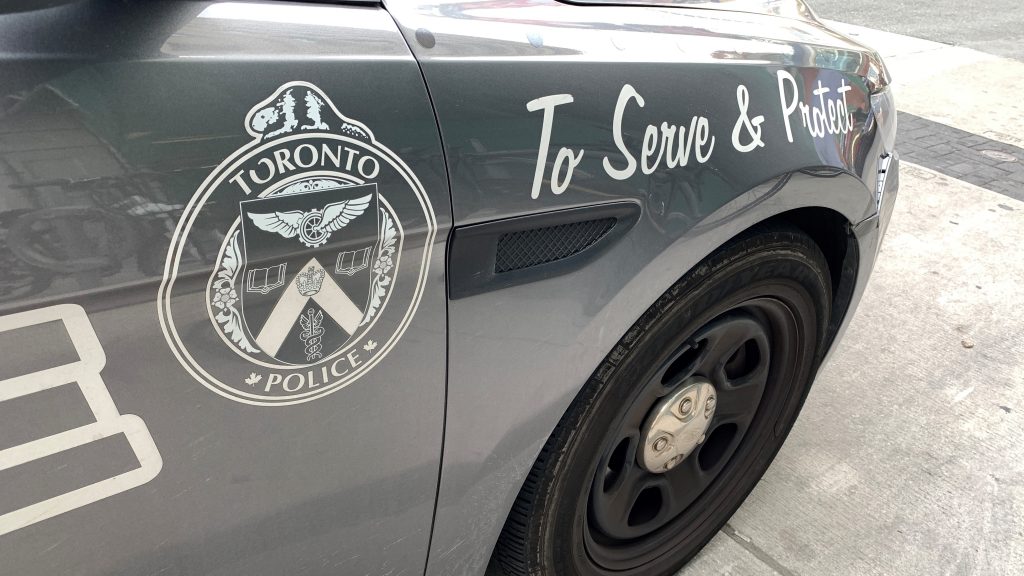Black people ‘disproportionately’ arrested, struck, shot by police, report finds

Posted August 10, 2020 8:53 am.
Last Updated August 10, 2020 5:13 pm.
The idea that the Toronto police are less racist than their American counterparts is a “myth,” according to the head of the Ontario Human Rights Commission.
Ena Chadha, the OHRC’s interim chief commissioner, spoke following the release of two reports by Ontario’s human rights commission that found Black people in Toronto are “disproportionately” arrested, charged and subjected to use of force by the city’s police force.
“The likelihood of a Black person being shot by police in Toronto is just as high as for a Black person in the average city in the United States,” said Chadha on Monday. “The time for debate about whether systemic racism or anti-Black racism exists is over.”
The commission’s reports found that Black people are more likely to be “arrested, charged, over-charged, struck, shot or killed by Toronto police.”
It found that despite the fact Black people represent only about 8.8 per cent of the city’s population, they represented almost a third of all charges in the data.
The findings are part of the commission’s second interim report into anti-Black racial profiling and discrimination by the Toronto Police Service. Titled “A Disparate Impact,” the report analyzed Toronto police data from 2013 to 2017.
You can read the full report below:
A Disparate Impact: second interim report on the TPS inquiry by CityNewsToronto on Scribd
“It is incumbent upon us all to re-envision the practices, the policies, the procedures, and importantly, the perceptions that shape policing in our city,” said Chadha. “The disproportionality, and the disparities in the commission report are more than just statistics. They are Black lives and Black Lives Matter.”
University of Toronto criminology professor Scot Wortley, who led the analysis, said the findings warrant “significant reform.” He also noted that Black people were “grossly over-represented” in police use of force and arrest incidents.
“This disparity cannot be explained away by racial differences in criminal history, civilian behaviour towards the police at the time of the incident, civilian weapons use, civilian mental illness, civilian intoxication, or local crime rates,” said Wortley.
The commission launched its inquiry in November 2017, and released its first interim report the following year.
The first interim report found that between 2013 and 2017, a Black person in Toronto was 20 times more likely to be shot and killed by police than a white person.
In examining reports by the province’s police watchdog, the Special Investigations Unit, the inquiry also found that officers sometimes lacked a legal basis for stopping or detaining Black people, searched them without justification and made unnecessary arrests and laid unnecessary charges.
“We don’t have an information problem, we have an accountability problem when it comes to policing within this city,” said Anthony Morgan, a lawyer who is also the manager of the City of Toronto’s Confronting Anti-Black Racism Unit.
Morgan noted that the reports’ effectiveness will be determined by how accountable public policy makers are in their wake and what changes are made within Toronto’s criminal and justice system.
The force and the city’s police services board issued a joint statement on Monday that said they accepted recommendations contained in the report, and later began collecting race-based data at the commission’s request.
Solicitor General Sylvia Jones said that Ontario has been “very active in doing things already” by increasing investment in community mental health and addiction resources, which she said account for 40 per cent of calls to emergency services.
“At the end of the day, when someone calls 911 they need to know that a police officer will show up at their door,” said Jones. “But is there an opportunity for other community agencies to do more? Absolutely.”
The Toronto Police Service is among many departments facing renewed scrutiny for their interactions with people of colour.
The police killing of George Floyd in Minneapolis in May sparked protests and calls to defund police services in the United States, Canada and around the world. Floyd died as a police officer pressed a knee against his neck for nearly nine minutes.
In Toronto, protesters also pointed to the death of Regis Korchinski-Paquet, a 29-year-old Black woman who fell to her death from a balcony while police were in her apartment. Critics have called for reform in how mental health calls are treated in the city.
Korchinski-Paquet’s family has said they wanted her to be taken to a mental health facility, while officers said they were responding to a call about a possible assault.
The SIU is probing the circumstances surrounding her death, and has said a report could come as early as this month.








